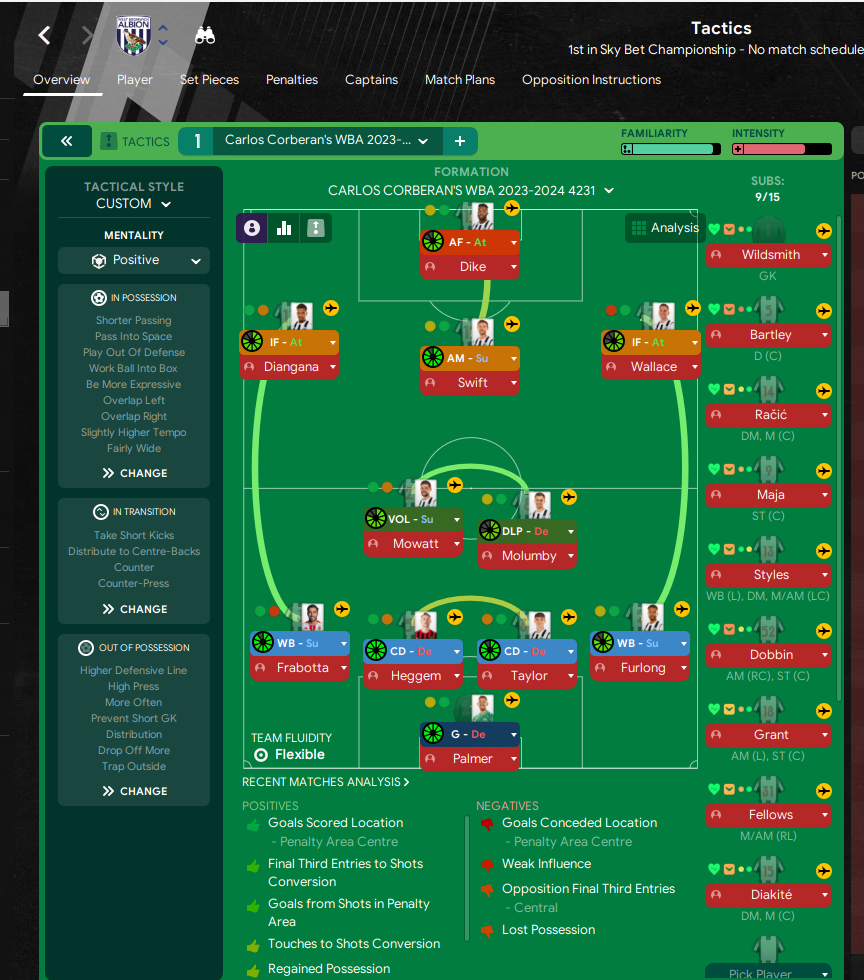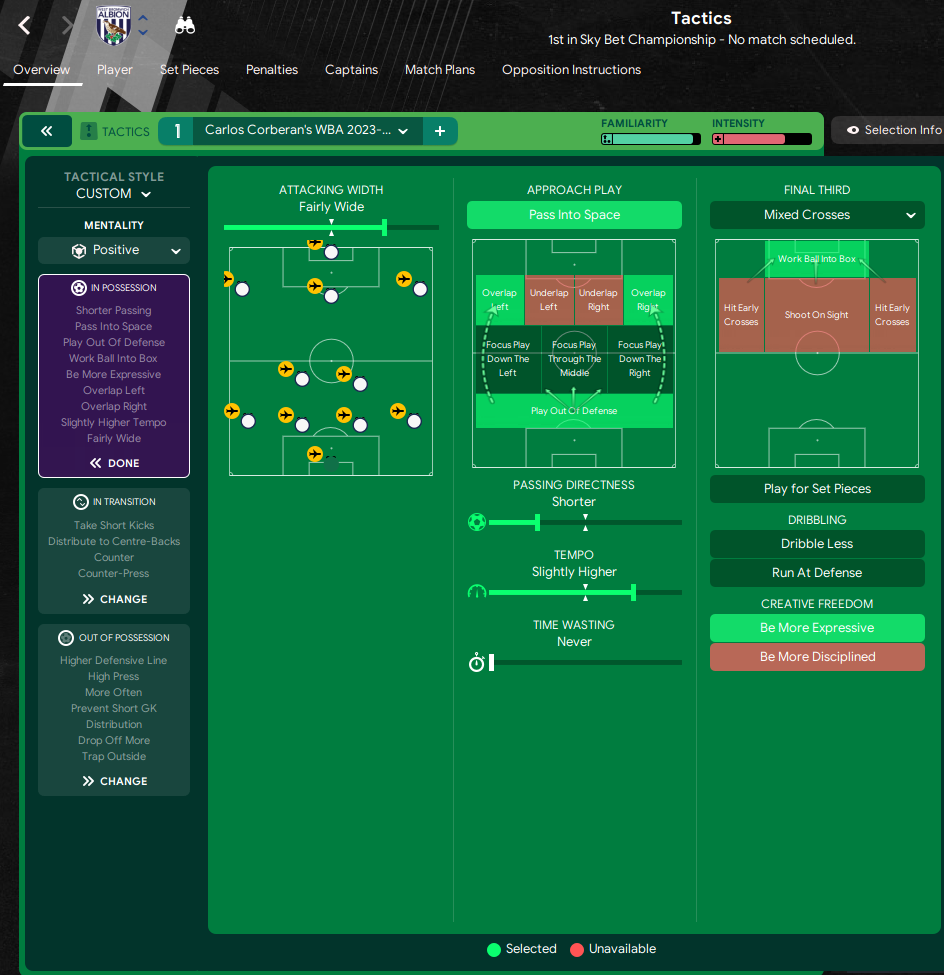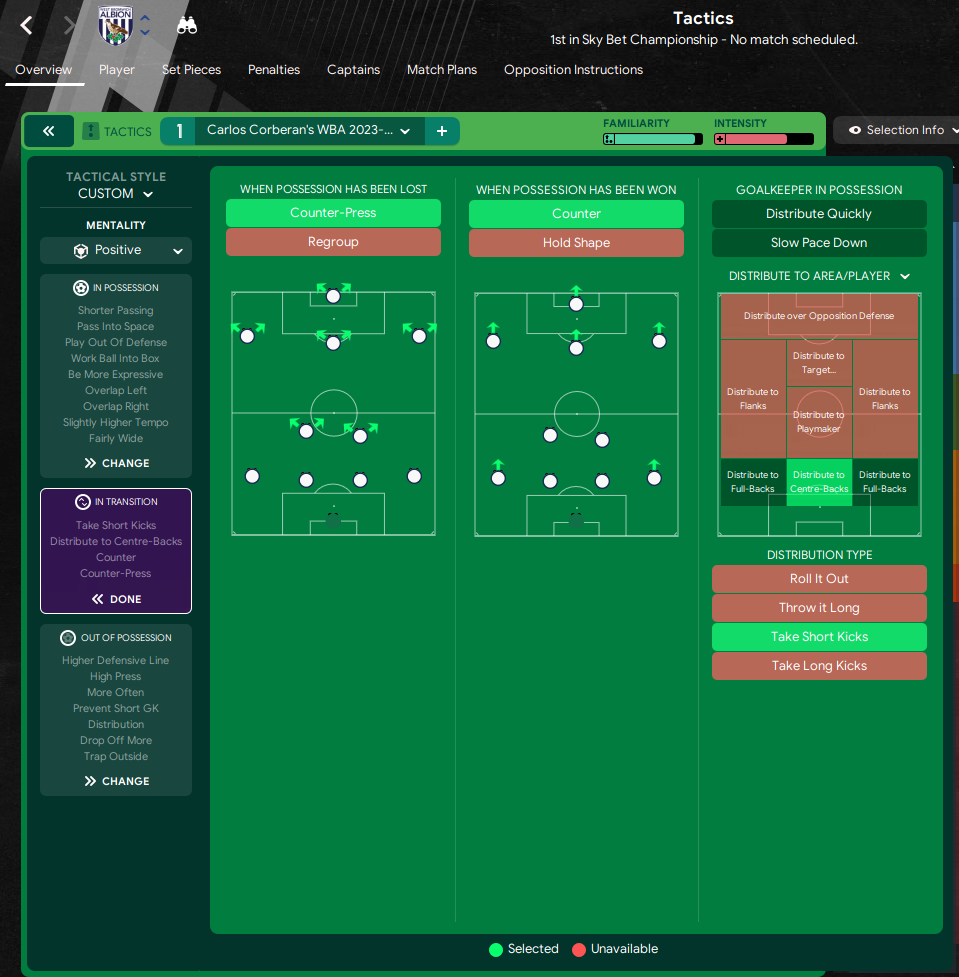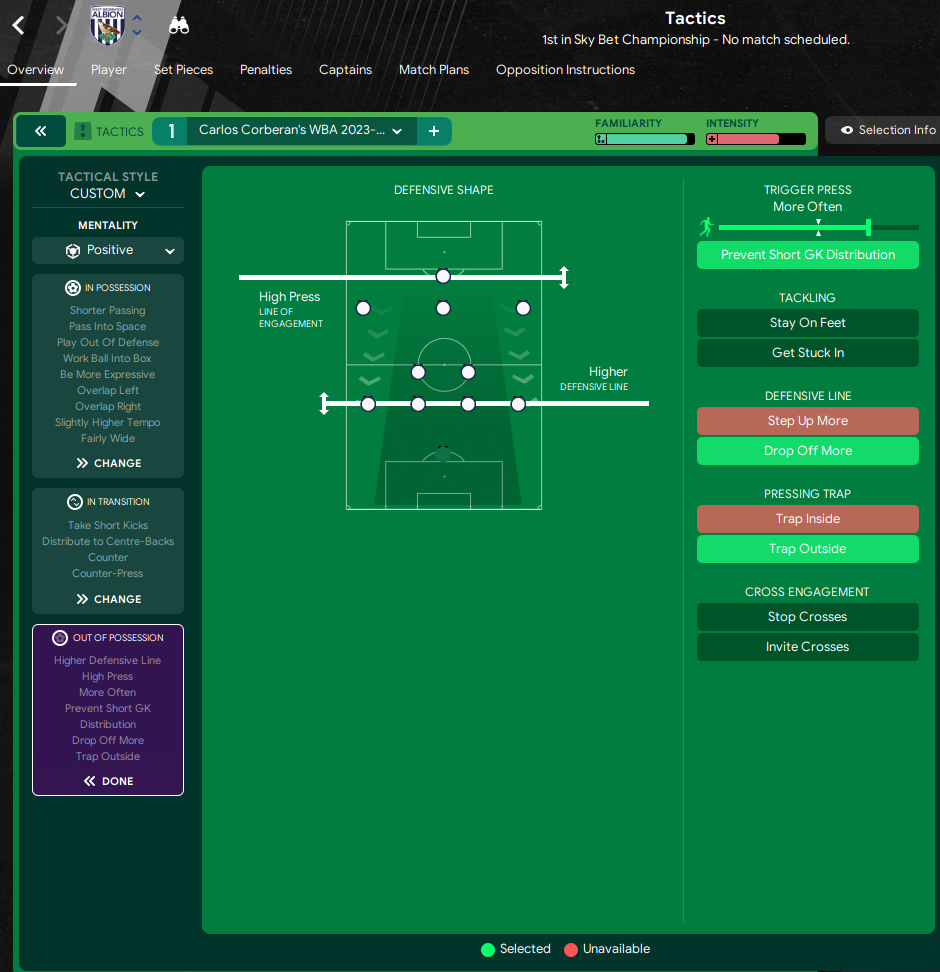Data Update Poll!
Hello, there is currently an important debate going on regarding how to manage the FM24 Data Update going forward, particularly in the case of modifying the ages and contract dates by 1 year. Please can you vote in the poll and join in the discussion.
| Tester | Team | ME | Win % | PPG | AGF | AGA | GD | PL | W | D | L | |
|---|---|---|---|---|---|---|---|---|---|---|---|---|
| Deleted User #1866315 |
 West Brom
West Brom
|
24.3 | 74% | 2.43 | 2.5 | 1.0 | 1.52 | 46 | 34 | 10 | 2 |
CARLOS CORBERAN’S WEST BROMWICH TACTIC ANALYSIS
Tactical Set-up at West Brom
West Brom saw a significant turnaround after a new coach joined the club midway through last season when they were in the relegation zone. The team's form improved remarkably, nearly securing a playoff spot by the season's end. Despite financial difficulties and the departure of a key player, expectations were low for this season. However, the coach recognized the potential within the squad, propelling them to fifth place after a narrow victory over Norwich City. The team has become adaptable, consistently defeating lower-ranked teams and competing well against top-tier opponents.
Defensive Strategy
West Brom initially struggled defensively, conceding 11 goals in their first six games. However, they have since become the best defensive side in the division, leading in clean sheets. The players are well aware of their responsibilities in each defensive phase, contributing to this success.
In defense, West Brom uses four zones, each guiding player decision-making based on the opponent's position on the field.
High Press
The team’s pressing strategy varies depending on the opposition but always focuses on forcing opponents into specific zones and applying intense pressure to regain possession. In a match against Leicester, West Brom employed a man-to-man marking strategy during goal kicks, pushing Leicester players into making mistakes high up the pitch.
When the opposition goalkeeper initiated play, West Brom's forwards strategically positioned themselves to block passing options, forcing errors that allowed West Brom to regain possession. A similar pressing approach was used against Ipswich, with adjustments made to exploit their specific build-up shape.
High and Mid-block
West Brom’s defensive shape in a high block can change slightly depending on the opponent, often forming either a 4-3-3 or a 4-4-2. In this setup, they aim to block passes into midfield and trap the ball wide, where they can apply pressure. The high block is characterized by intense running, aggressive midfield play, and precise positioning.
In a mid-block, West Brom adopts a more compact 4-4-2 shape, focusing on blocking central progression and pushing the opponent back when possible. The principles remain similar to those in the high block, but with reduced intensity.
Low Block
West Brom’s low block is one of the most disciplined in the Championship, characterized by compactness and a willingness to defend resolutely in the penalty area. The team typically forms a narrow 4-4-2 shape, adjusting to create a 2v1 advantage when the ball is wide. However, this strategy has a vulnerability: the gap between fullback and center-back can be exploited, especially when the midfield struggles to track runners into this space.
Artificial Transitions
West Brom is adept at creating artificial transitions in settled play by baiting the press and exploiting space. This tactic was exemplified in a goal against Hull City, where the team used forward-backward-forward combinations in midfield to escape pressure and create attacking opportunities. The attacking principles are straightforward: play wide, commit defenders, and trust the wingers to make the right decisions.
Build-up Play
When opponents prevent artificial transitions, West Brom’s wingers move inside to help create overloads and facilitate ball movement into wide positions. This approach opens up passing lanes to the striker or runners in behind. Positional rotations are often used to efficiently move the ball forward, as demonstrated in a match against Leicester.
Creating Space through Off-The-Ball Movement
West Brom effectively uses off-the-ball movement to create space for wide players. For example, their attacking midfielder often drifts into spaces left by full-backs, creating opportunities to exploit wide areas. These movements are practiced in training and are crucial for creating space, although there’s a trade-off in losing the advantage of having certain players arrive onto the ball with space to run into.
Challenges against Set Defenses
West Brom tends to score most of their goals from transitions and set pieces, often struggling against set defenses. One of the main issues is the lack of a quality finisher in the box, leading to a reliance on cut-back opportunities from wide positions. However, the fullbacks do not offer much threat in advanced positions, causing play to slow down as they try to create space for the wingers. Despite these challenges, the team has recently adjusted its strategy, instructing wingers to cut inside and deliver inswinging crosses to the back post, with mixed success.
West Brom’s Defensive Strategy Analysis
There's an old saying: "Attack wins games, but defense wins titles." This wisdom, famously shared by legendary manager Sir Alex Ferguson, has been proven true time and again. A solid defense can also stabilize a team with less impressive attacking performance, a description that suits West Bromwich Albion well this season. Currently sitting fifth in the EFL Championship with 12 games left, their defensive prowess is a key asset.
West Brom’s standout quality this season has been their ability to keep clean sheets. Out of their 16 victories, 12 were achieved without conceding a goal, contributing to a total of 15 clean sheets in league play. However, their offensive output has been less remarkable—49 goals, which, while not poor, is the lowest among the top six teams, and several lower-ranked teams have outscored them.
This report will analyze West Brom’s defensive setup under Carlos Corberán, focusing on the tactics used when the team is without the ball. Understanding these strategies is crucial, as they could be the key to West Brom’s potential return to the Premier League. This analysis will incorporate key data and examples from games to provide insights into their defensive performance.
Formation & Defensive Personnel
The 4-4-2 formation has been a cornerstone for West Brom this season, as Corberán has leveraged his team's defensive strengths to improve on last year’s ninth-place finish. While 4-4-2 is less common nowadays, it offers a balanced tactical approach and fluid transitions between different phases of play. Occasionally, Corberán has switched to a 4-2-3-1 setup, but the core defensive principles remain unchanged, focusing on positional discipline.
West Brom's defensive tactics rely heavily on teamwork to disrupt passing lanes and block access points, which is why they rank lower in individual defensive actions, like duels. This cohesive approach requires each player to have a deep understanding of the tactics, as well as strong mental attributes. Interestingly, West Brom has the second-oldest squad in the Championship, with an average age of 27.9, which likely contributes to their cohesion and tactical awareness.
The team has maintained a consistent lineup, especially in defense. Darnell Furlong and Conor Townsend have been the regular full-backs, while Cédric Kipré and Kyle Bartley have mostly paired as center-backs, with Erik Pieters and Semi Ajayi providing occasional relief. Goalkeeper Alex Palmer has also solidified his role as the first-choice keeper, delivering reliable performances behind a defense that limits opponents to few chances.
The Mid-Block Strategy
West Brom doesn’t employ a high-intensity pressing game. With a PPDA (passes per defensive action) of 13.3, slightly above the league average, and a challenge intensity of 4.6, the lowest in the Championship, they prefer a patient, strategically-timed approach to pressing. This tactic involves maintaining a mid-block, waiting for the right moment to squeeze space and force opponents into mistakes.
Defensive actions for West Brom are concentrated in deep midfield areas, with significant activity on the wings. A key aspect of Corberán’s defensive philosophy is discipline, both tactically and technically. Notably, the team has not committed a single foul inside the box all season and has only given away one foul in a potentially dangerous area outside the box. This discipline minimizes the opponent's chances to capitalize on set pieces.
West Brom’s disciplined approach extends to their overall play, as they average just 7.32 fouls per game, the lowest in the Championship. Although not aggressive, they are far from passive, showing tactical awareness in choosing when to press and when to drop back.
Defending the Box
West Brom’s measured pressing style serves them well in defending their box. They apply similar principles, pressing at the right moments and cutting off dangerous passing lanes. This analysis highlights their skill in defensive recovery—quickly reorganizing to form a solid defensive unit during critical moments.
West Brom has conceded only 32 goals this season, averaging 0.85 goals per game, with only Leeds and Leicester boasting better records. The team's success in defending the box is reflected in their low xG (expected goals) against—37.16, the second-best in the Championship. They also face few shots, with Alex Palmer facing just 8.84 shots per game, the third-lowest in the league.
West Brom prefers to defend as a unit rather than relying on individual duels, as indicated by their league-low average of 47.49 defensive duels per game, despite a strong 63% win rate. This approach helps avoid risky 1v1 situations, instead forcing opponents into less favorable shots or turnovers.
Conclusion
West Bromwich Albion’s defensive strategies, emphasizing teamwork and discipline, have been crucial in keeping them in playoff contention. While their attack could use improvement, the defensive solidity fostered by Corberán might just provide the edge they need in the playoffs. If they continue to defend as effectively as they have, it could be their ticket back to the Premier League.
HOW TO EMULATE THIS TACTIC IN FOOTBALL MANAGER 2024
Creating a Football Manager 2024 tactic based on Carlos Corberan's 4-2-3-1 system at West Brom requires replicating the key principles described in the analysis. Here’s how you can set it up:
Formation: 4-2-3-1
- GK: Goalkeeper (Defend)
- DR:Wing-Back (Support)
- DC: Central Defender (Defend)
- DC: Central Defender (Defend)
- DL: Wing-Back (Support)
- MCR: Deep-Lying Playmaker (Defend)
- MCL: Box-to-Box Midfielder (Support)
- AMR: Inside Forward (Attack)
- AMC: Attacking Midfielder (Support)
- AML: Inside Forward (Attack)
- ST: Advanced Forward (Attack)
Team Mentality: Positive
Corberan’s style is proactive, looking to control possession and press high but with a balanced approach to defending and attacking.
In Possession:
- Pass Into Space: Encourages the team to exploit space, particularly useful for counter-attacks and creating artificial transitions.
- Play Out of Defense: To maintain control and build from the back, emphasizing the short-passing combinations.
- Work Ball Into Box: Reflects the tendency to create cut-back opportunities, working the ball patiently into good positions.
- Overlap Left & Right: Utilizes full-backs to provide width and support for inside forwards, reflecting the movement into wide areas.
- Shorter Passing: Keeps the passing short and controlled, mimicking the controlled build-up play.
- Be More Expressive: Allows creative players like the attacking midfielder and wingers to use their flair to break down defenses.
- Fairly wide attacking width: the two wing-backs will provide width with their overlaps, the rest of the players will decide according to the situation
- Slightly higher tempo: build up faster with short passes
- Mixed crosses: use whipped if you have a tall striker, low crosses if your striker is not so tall.
Transition:
- Counter-Press: Immediately press the opposition after losing the ball, reflecting the high-press and aggressive approach to regaining possession.
- Counter: Quickly transition to attack once the ball is won, exploiting space and pushing the team forward.
- Distribute to Centre-Backs: Ensures the build-up play starts from the back, crucial for creating those forward-backward-forward passing moves.
- Take Short Kicks: Encourages the goalkeeper to distribute the ball short to the defenders to maintain possession.
Out of Possession:
- Higher Defensive Line: Pushes the defense higher up the pitch, compressing the space available for the opponent and helping the team press effectively.
- High Pressing: Engage the opposition high up the pitch, with a focus on forcing them wide or into mistakes.
- Prevent Short GK Distribution: To ensure the opposition goalkeeper cannot easily play out from the back, aligning with the man-to-man pressing strategy.
- Trigger press more often: WBA applies high pressing to force the opponent to make mistakes
- Drop off more: to avoid allowing too many counterattacks
- Trap outside: use the sideline as an additional defender, forcing the opponent to play wider where they have less choices.
Player Roles & Instructions:
- GK - Goalkeeper (Defend): take fewer risks
- DR/DL - Wing-Back (Support):
- Sit Narrower: This instruction can help them tuck in to maintain compactness in defense.
- Cross More Often: To provide crosses for the forwards when in attacking positions.
- DC - Central Defenders (Defend):
- Stay Wider: Helps cover the full-backs when they push forward.
- Close down less often: to avoid they get too high when pressing the opponent leaving spaces behind
- Take fewer risks: this to avoid our central defenders to make mistakes in passing the ball in dangerous areas
- MCR - Deep-Lying Playmaker (Defend): no instructions
- MCL - Segundo volante (Support):
- Get Further Forward: Adds an extra body in attack during transitions.
- Shoot Less Often: Encourages passing instead of taking speculative shots.
- Move Into Channels: Drifts wide to create overloads and find space.
- AMR/AML - Inside Forward (Attack):
- Sit Narrower: To create space for overlapping full-backs and cut inside onto their stronger foot.
- Roam From Position: Allows freedom to exploit spaces in the defense.
- AMC - Attacking Midfielder (Support):
- Move Into Channels: Drifts wide to create overloads and find space.
- Dribble Less: Focuses on passing and linking play instead of individual dribbles.
- Get Further Forward: Adds an extra body in attack during transitions.
- ST - Advanced Forward (Attack):
- Tackle harder: Reflects the need for high work rate in pressing the opposition defenders.
Opposition Instructions (OI): I don’t use any but if you want you can set “tight marking” against the strongest players
This setup should closely mirror the tactical principles and style of play that Corberan has implemented at West Brom, focusing on a solid defense, high pressing, and quick, controlled transitions. Adjustments can be made depending on the specific strengths and weaknesses of your squad in Football Manager 2024.
Test Results
 West Brom
West Brom
You'll need to Login to comment




